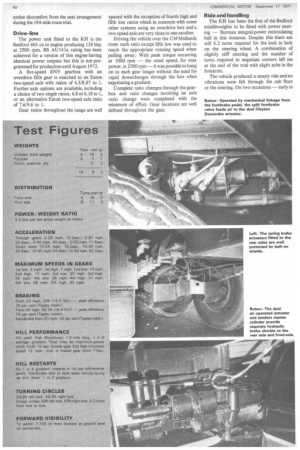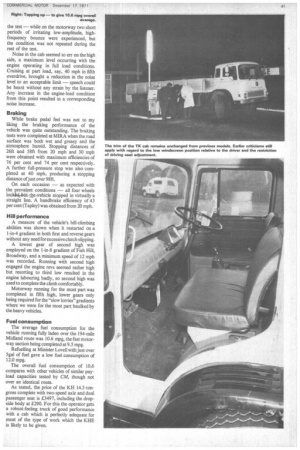BEDFORD KHE 14.5--TON-GVW FOUR-WHEELER
Page 40

Page 42

Page 43

If you've noticed an error in this article please click here to report it so we can fix it.
by Trevor Longcroft
THE BEDFORD TK range, in various forms, has been available to operators for nearly 15 years and in that time improvements in design and construction have brought the models to a highly developed standard.
A new set of design improvements was announced throughout the range of Bedford trucks in October this year (CM October 8). These were concerned mainly with updated braking systems and revised and simplified gvw graduations. Other changes involved better suspension designs and the adoption as standard of several features which were previously available only as options.
To fill the gap between the 13-ton-gross KH and the 16-ton-gross KM, Vauxhall has uprated the KH to 14.5 tons gross with plated axle weights of 5 tons front and 10 tons rear, and we have just tested one of these KHE models.
The 14.5-ton-gross KH with a payload of about 10 tons popular with own-account operators in the distributive trades and general hauliers employs similar front and rear axles to those used on the popular KM 16-tonner. The suspension has been further reinforced by wider rear springs incorporating slipper-type rear hangers and larger-diameter shock absorbers.
A further change not confined to the KH models has been the introduction of a dual air/hydraulic brake system, and spring-operated parking brakes instead of the transmission brake so long associated with Bedford commercials.
General impressions
Changes to the well-known Bedford TK cab are limited to the change in brake, specification. A dual air-pressure gauge with low-pressure warning light and buzzer is fitted to the left side of the instrument panel and the parking brake hand-control valve is located to the right side of the driver in a similar position to the transmission handbrake lever previously fitted. A dual passenger seat was fitted on our test vehicle.
Clutch pedal pressure was pleasantly light, but the footbrake tended to be rather spongy, the response to foot pressure not being met by the retardation one would normally expect but actual stopping performance proved excellent.
The driving seat adjusts only forwards and backwards and I found the seat rather low; but despite this, all controls were within easy reach of the driver and I suffered no undue discomfort from the seat arrangement during the 194-mile route trial.
Drive-line
The power unit fitted to the KH is the Bedford 466 cu in engine producing 138 bhp at 2500 rpm. BS AU 141a rating has been achieved for a version of this engine having identical power outputs but this is not programmed for production until August 1972.
A five-speed ENV gearbox with an overdrive fifth gear is matched to an Eaton two-speed axle with ratios of 6.5/8.87 to 1. Further axle options are available, including a choice of two single ratios, 6.8 or 6.18 to 1, or an alternative Eaton two-speed axle ratio of 7.6/9.6 to 1.
Gear ratios throughout the range are well spaced with the exception of fourth high and fifth low ratios which in common with some other systems using an overdrive box and a two-speed axle are very close to one another.
Driving the vehicle over the CMMidlands route each ratio except fifth low was used to reach the appropriate running speed when pulling away. With peak torque occurring at 1000 rpm — the rated speed, for max power, is 2500 rpm— it was possible to hang on to each gear longer without the need for rapid downchanges through the box when negotiating a gradient.
Complete ratio changes through the gearbox and ratio changes involving an axle ratio change were completed with the minimum of effort. Gear locations are well defined throughout the gate.
Ride and handling
The KH has been the first of the Bedford middleweights to be fitted with power steering — Burman integral-power recirculating ball in this instance. Despite this there are still 6.2 turns required for the lock to lock on the steering wheel. A combination of slightly stiff steering and the number of turns required to negotiate corners left me at the end of the trial with slight ache in the forearms.
The vehicle produced a steady ride and no vibrations were felt through the cab floor or the steering. On two occasions early in the test — while on the motorway two short periods of irritating low-amplitude, highfrequency bounce were experienced, but the condition was not repeated during the rest of the test.
Noise in the cab seemed to err on the high side, a maximum level occurring with the engine operating in full load conditions. Cruising at part load, say, 40 mph in fifth overdrive, brought a reduction in the noise level to an acceptable limit — speech could be heard without any strain by the listener. Any increase in the engine-load condition from this point resulted in a corresponding noise increase.
Braking While brake pedal feel was not to my liking the braking performance of the vehicle was quite outstanding. The braking tests were completed at MIRA when the road surface was both wet and greasy and the atmosphere humid. Stopping distances of 26ft and 58ft from 20 mph and 30 mph were obtained with maximum efficiencies of 76 per cent and 74 per cent respectively. A further full-pressure stop was also completed at 40 mph, producing a stopping distance of just over 9811.
On each occasion — as expected with the prevalent conditions — all four wheels 1ockok14)(ii.the +vehicle stopped in virtually a straight line. A handbrake efficiency of 43 per cent (Tapley) was obtained from 20 mph.
Hill performance A measure of the vehicle's hill-climbing abilities was shown when it restarted on a 1-in-4 gradient in both first and reverse gears without any need forexcessive clutch slipping.
A lowest gear of second high was employed on the 1-in-8 gradient of Fish Hill, Broadway, and a minimum speed of 12 mph was recorded. Running with second high engaged the engine revs seemed rather high but resorting to third low resulted in the engine labouring badly, so second high was used to complete the climb comfortably.
Motorway running for the most part was completed in fifth high, lower gears only being required for the "slow lorries" gradients where we were for the most part baulked by the heavy vehicles.
Fuel consumption The average fuel consumption for the vehicle running fully laden over the 194-mile Midland route was 10.6 mpg, the fast motorway section being completed at 9.5 mpg.
Refuelling at Minister Lovell with just over 5gal of fuel gave a low fuel consumption of 12.0 mpg.
The overall fuel consumption of 10.6 compares with other vehicles of similar payload capacities tested by CM, though not over an identical route.
As tested, the price of the KH 14.5-tongross complete with two-speed axle and dual passenger seat is £3497, including the dropside body at £290. For this the operator gets a robust-feeling truck of good performance with a cab which is perfectly adequate for most of the type of work which the KHE is likely to be given.
































































































